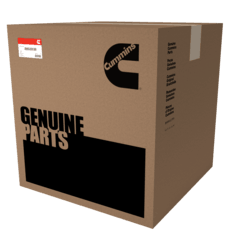This truck part is made by Cummins®. We guarantee that all of our parts are from the OEM (original equipment manufacturer), ensuring a proper fit and quality manufacturing.
We honor the warranty provided by the original equipment manufacturer.
Introduction
Cummins Part #5362108 Sealant is a specialized product designed to ensure the integrity and efficiency of commercial truck engines. Sealants play a crucial role in automotive applications, particularly in high-stress environments like commercial truck engines, where preventing leaks and maintaining engine performance is paramount 1.
Basic Concepts Related to Sealant and How It Works
Sealants are materials used to fill joints and prevent leakage between surfaces. In automotive applications, sealants are essential for maintaining the integrity of engine components by preventing the escape of fluids and gases 2. The chemical composition of sealants varies, with common types including silicone, polyurethane, and acrylic-based sealants. Each type offers unique properties such as flexibility, resistance to chemicals, and temperature extremes. The mechanism of action involves the sealant adhering to surfaces, curing to form a solid, impermeable barrier that effectively seals gaps and joints.
Purpose of Cummins Part #5362108 Sealant in Truck Engines
This Cummins part is specifically formulated to address the demanding conditions within commercial truck engines. Its primary role is to seal gaskets, joints, and connections, ensuring that engine fluids and gases remain contained. This sealing is critical for maintaining engine efficiency, preventing leaks that could lead to costly repairs, and ensuring the overall integrity of the engine 3. The benefits of using this part include enhanced engine performance, reduced maintenance costs, and extended engine life.
Cummins: A Leader in Engine Technology
Cummins has established itself as a leader in the automotive industry, known for its commitment to quality and innovation. With a rich history of developing reliable and high-performance engine components, Cummins’ product range is significant in the market. Their dedication to excellence ensures that components like the 5362108 meet the rigorous demands of commercial truck engines.
Troubleshooting and Maintenance
Sealant failure can lead to significant issues in truck engines, including leaks and reduced performance. Common symptoms of sealant degradation include visible leaks, unusual engine noises, and a drop in engine efficiency. Troubleshooting sealant-related problems involves inspecting joints and connections for signs of wear or damage, and replacing the sealant as necessary. Maintenance tips to prolong the life of this part include regular inspections, proper application techniques, and ensuring that surfaces are clean and dry before application. Best practices also involve following manufacturer guidelines for application and reapplication intervals.
Expert Insights and Best Practices
Industry experts emphasize the importance of using the right sealant for specific engine components to ensure optimal performance. Case studies and real-world examples highlight the effectiveness of this part in maintaining engine integrity under various operating conditions. Recommendations for selecting the right sealant include considering the operating environment, temperature ranges, and chemical exposure. Ensuring optimal performance and longevity of sealants involves adhering to best practices in application and maintenance, as well as staying informed about advancements in sealant technology.
Conclusion
Cummins Part #5362108 Sealant is a vital component in the maintenance and efficiency of commercial truck engines. Proper maintenance and troubleshooting are essential in extending the life of sealants and ensuring the continued performance of engine components. Utilizing Cummins’ high-quality products, such as Part #5362108, is encouraged for those seeking reliability and durability in their commercial truck operations.
-
Lakshminarayanan, P. A., & Agarwal, A. K. (2019). Design and Development of Heavy Duty Diesel Engines: A Handbook. Springer.
↩ -
Bonnick, A. (2004). A Practical Approach to Motor Vehicle Engineering and Maintenance. Elsevier.
↩ -
Reif, K. (2014). Diesel Engine Management Systems and Components. Springer.
↩
SPECIFICATIONS
RECOMMENDED PARTS
* Variable geometry turbocharger and electronic actuator repairs are not eligible to be claimed as over-the-counter under New or ReCon parts warranty for parts installed after October 1, 2018.
* Diesel Oxidation Catalyst (DOC), Diesel Particulate Filter (DPF), Selective Catalyst Reduction (SCR) catalyst, and Electronic Control Module (ECM) repairs are not eligible to be claimed as over-the-counter under New or ReCon parts warranty for parts installed after January 1, 2020.
* These restrictions are only applicable to New parts and ReCon parts coverages for the components listed above sold to a customer in the US or Canada. All other coverages are excluded. All other regions are excluded.

